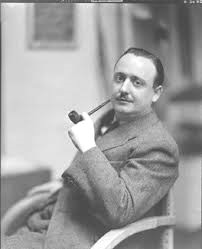
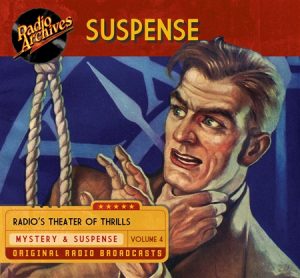 Suspense is compounded of mystery and suspicion and dangerous adventure. In this series are tales calculated to intrigue you, to stir your nerves, to offer you a precarious situation and then withhold the solution… until the last possible moment when we again hope to keep you in…Suspense!
Suspense is compounded of mystery and suspicion and dangerous adventure. In this series are tales calculated to intrigue you, to stir your nerves, to offer you a precarious situation and then withhold the solution… until the last possible moment when we again hope to keep you in…Suspense!
Suspense (1942-1962) aired “The Dead Sleep Lightly” on March 30, 1943 as the 35th of its 945 episodes.
As recounted in the introduction to the more than 50 episodes of Suspense we’ve shared over the past fourteen years, it was such a rich goldmine of superior stories that we found each one has had something unique to offer. Suspense was one of the most well produced, written, acted, and critically acclaimed of all radio shows during the Golden Age of Radio, many a film star jumping at the chance to perform in an episode, among them Cary Grant, Orson Welles, Jimmy Stewart, Susan Hayward, Vincent Price, Charles Laughton, Loretta Young, Peter Lorre, and Rita Hayworth. After many another radio show had gasped its last breath during the 1950s, Suspense (along with Yours Truly, Johnny Dollar) finally closed shop in September of 1962 whereupon radio historians proclaimed the Golden Age of Radio dead, television having become the medium of choice in America.
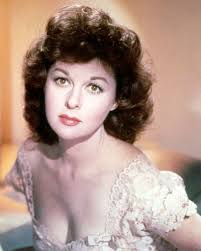 Written by acclaimed mystery writer John Dickson Carr (1906-77, photo top right) and co-starring future Academy Award winning actress Susan Hayward (1917-1975, photo at right), “The Dead Sleep Lightly” opens at the Meadowvale cemetery not far from New York City, during a burial service performed on a solemn, grey day shrouded in mist, surrounded by leafless trees and white gravestones as the few onlookers attending the lowering of the casket watch in peaceful reverence. The silence is then broken by the voices of several of those in attendance after one of them cries out “She’s not alive, I tell you. She’s not alive!” and it is with this unseemly exclamation that our story quickly unfolds. And a strange story it is, full of quirky details surrounding the deceased of the mourner who cried out and how and why her death occurred, and finally the unforeseen effect it has on him. But as can be expected in this sort of graveside tale there is much more than meets the eye, and John Dickson Carr weaves a slickly plotted series of incidents to tantalize the listener, one moving creepily into supernatural territory, making “The Dead Sleep Lightly” a memorable twist on the mourners-at-a-funeral sub-genre and definitely worth a listen.
Written by acclaimed mystery writer John Dickson Carr (1906-77, photo top right) and co-starring future Academy Award winning actress Susan Hayward (1917-1975, photo at right), “The Dead Sleep Lightly” opens at the Meadowvale cemetery not far from New York City, during a burial service performed on a solemn, grey day shrouded in mist, surrounded by leafless trees and white gravestones as the few onlookers attending the lowering of the casket watch in peaceful reverence. The silence is then broken by the voices of several of those in attendance after one of them cries out “She’s not alive, I tell you. She’s not alive!” and it is with this unseemly exclamation that our story quickly unfolds. And a strange story it is, full of quirky details surrounding the deceased of the mourner who cried out and how and why her death occurred, and finally the unforeseen effect it has on him. But as can be expected in this sort of graveside tale there is much more than meets the eye, and John Dickson Carr weaves a slickly plotted series of incidents to tantalize the listener, one moving creepily into supernatural territory, making “The Dead Sleep Lightly” a memorable twist on the mourners-at-a-funeral sub-genre and definitely worth a listen.
(The linked Suspense CD at top includes this episode and 11 others.)
Play Time: 29:47
{Broadcast on a Tuesday evening in late March of 1943, “The Dead Sleep Lightly” found the neighborhood gang sleeping lightly that night despite themselves. The next day at school seemed like an eternity until the last bell rang, and then it was a race to their usual home away from home, the nearby newsstand, where all thoughts of cemeteries and ghosts would soon be forgotten within the pages of the following magazines, where even a few copies of February issues yet remained, soon to be restocked with new ones. Astounding SF (1930-present, now Analog) had long been their favorite SF pulp and this issue was no exception. The text teasing the cover story “Clash by Night” was bylined as by Lawrence O’Donnell, though the gang probably wasn’t aware that this was one of the pseudonyms of the highly acclaimed husband and wife writing team of Henry Kuttner and C. L. Moore. Astounding held to its usual monthly schedule in 1943. Future Fantasy and Science Fiction (1939-43) managed only 17 issues in its rocky existence, but nevertheless attracted popular writers like Ray Cummings, the iconic illustrator (who also wrote) Hannes Bok, Henry Kuttner, Edmond Hamilton, Manly Wade Wellman, F. Orlin Tremaine (former editor of Astounding in the 1930s), Frank Belknap Long, and L. Ron Hubbard. It saw three issues in 1943 with the July issue being its last. Thrilling Wonder Stories (1936-55) featured rock-em, sock-em page turning adventure stories with little regard for scientific accuracy, but it made up for this lack with heavy emphasis on colorful places and characters (not to mention BEMs–Bug-Eyed Monsters). Many of its wild fantastic tales by names now legend in the SF field have proven so popular down through the years that they have become classics, often included in reprint collections still sought in dealer rooms at SF conventions to this day–if they can be found at all. TWS was one of the most beloved of the early SF pulps, and though ostensibly a bi-monthly in 1943, it saw only 5 issues that year as it temporarily transitioned to a quarterly in 1944.}
[Left: Astounding, 3/43 – Center: Future F & SF, 2/43 – Right: Thrilling Wonder Stories, 2/43]
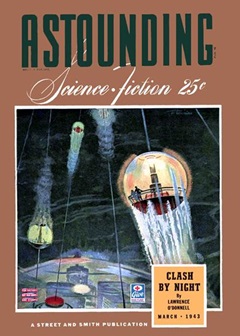
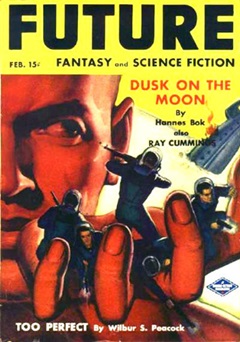
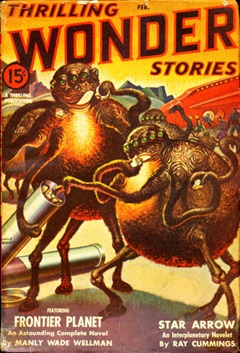
To view the entire list of weekly Old Time Radio episodes at Tangent Online, click here.